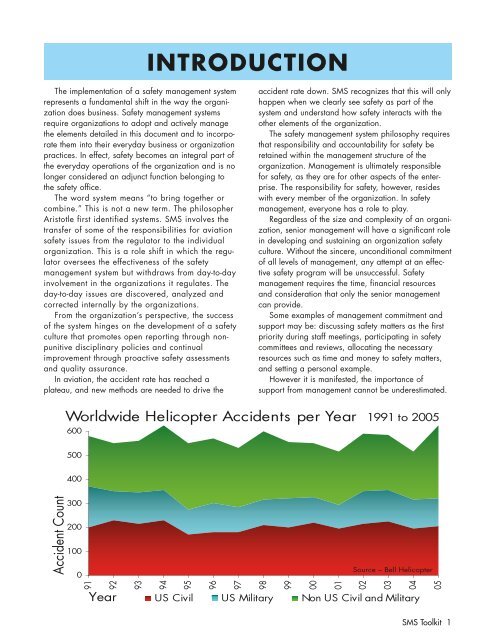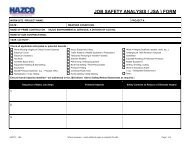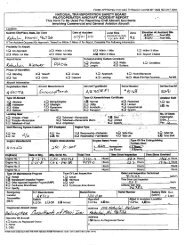International Helicopter Safety Team Safety Management System Toolkit
IHST - Safety Management Toolkit - Skybrary
IHST - Safety Management Toolkit - Skybrary
- No tags were found...
You also want an ePaper? Increase the reach of your titles
YUMPU automatically turns print PDFs into web optimized ePapers that Google loves.
INTRODUCTION<br />
The implementation of a safety management system<br />
represents a fundamental shift in the way the organization<br />
does business. <strong>Safety</strong> management systems<br />
require organizations to adopt and actively manage<br />
the elements detailed in this document and to incorporate<br />
them into their everyday business or organization<br />
practices. In effect, safety becomes an integral part of<br />
the everyday operations of the organization and is no<br />
longer considered an adjunct function belonging to<br />
the safety office.<br />
The word system means “to bring together or<br />
combine.” This is not a new term. The philosopher<br />
Aristotle first identified systems. SMS involves the<br />
transfer of some of the responsibilities for aviation<br />
safety issues from the regulator to the individual<br />
organization. This is a role shift in which the regulator<br />
oversees the effectiveness of the safety<br />
management system but withdraws from day-to-day<br />
involvement in the organizations it regulates. The<br />
day-to-day issues are discovered, analyzed and<br />
corrected internally by the organizations.<br />
From the organization’s perspective, the success<br />
of the system hinges on the development of a safety<br />
culture that promotes open reporting through nonpunitive<br />
disciplinary policies and continual<br />
improvement through proactive safety assessments<br />
and quality assurance.<br />
In aviation, the accident rate has reached a<br />
plateau, and new methods are needed to drive the<br />
accident rate down. SMS recognizes that this will only<br />
happen when we clearly see safety as part of the<br />
system and understand how safety interacts with the<br />
other elements of the organization.<br />
The safety management system philosophy requires<br />
that responsibility and accountability for safety be<br />
retained within the management structure of the<br />
organization. <strong>Management</strong> is ultimately responsible<br />
for safety, as they are for other aspects of the enterprise.<br />
The responsibility for safety, however, resides<br />
with every member of the organization. In safety<br />
management, everyone has a role to play.<br />
Regardless of the size and complexity of an organization,<br />
senior management will have a significant role<br />
in developing and sustaining an organization safety<br />
culture. Without the sincere, unconditional commitment<br />
of all levels of management, any attempt at an effective<br />
safety program will be unsuccessful. <strong>Safety</strong><br />
management requires the time, financial resources<br />
and consideration that only the senior management<br />
can provide.<br />
Some examples of management commitment and<br />
support may be: discussing safety matters as the first<br />
priority during staff meetings, participating in safety<br />
committees and reviews, allocating the necessary<br />
resources such as time and money to safety matters,<br />
and setting a personal example.<br />
However it is manifested, the importance of<br />
support from management cannot be underestimated.<br />
Worldwide<br />
<strong>Helicopter</strong> Accidents per Year 1991 to 2005<br />
600<br />
500<br />
400<br />
Accident Count<br />
300<br />
200<br />
100<br />
0<br />
Source – Bell <strong>Helicopter</strong><br />
91<br />
92<br />
Year<br />
93<br />
94<br />
US<br />
95<br />
Civil<br />
96<br />
US<br />
97<br />
98<br />
Militar y<br />
99<br />
00<br />
01<br />
Non US<br />
02<br />
03<br />
04<br />
Civil and Militar y<br />
05<br />
SMS <strong>Toolkit</strong> 1







